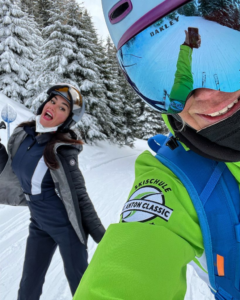By Anne-Louise S. Jørgensen, Ski Instructor & Off-Piste Guide in St. Anton am Arlberg, Austria.
How do I stay fit year-round for the ski season?
This is a frequent question I receive. For me, maintaining fitness all year has become a lifestyle commitment; I prioritize staying active and training my body. While there are periods of more intensive training, I also allow time for recovery, mobility, and stretching exercises.
Seasonal Variation
Summer & autumn
From June to September, when I’m in Denmark, I do a lot of running and cycle occasionally. I’m also active as a kitesurfer. From September to November, when I’m mostly in Austria, I prefer running and hiking in the mountains, along with mobility and stretching exercises on my rest days.
Winter
During winter, from December to end of April, my daily routine mainly consists of skiing, both on-piste and off-piste. Some days are more active than others, and I always adjust my training according to my body’s needs. I focus on swimming and taking long walks with my dog. As I age, it’s crucial to care for my joints and prevent injuries, so strength training is a year-round priority. I mainly use bodyweight and full-body exercises but may emphasize cardio training at times, as I enjoy the feeling it provides.
Importance of Base Fitness
I maintain a baseline fitness level that varies with the season and my athletic goals. It’s essential to me to have a strong and healthy body to tackle winter challenges and enjoy kitesurfing in the summer. This balance is something I strive to keep throughout my life.
8 Tips to Stay Fit for Your Ski Holiday or Ski Season
- Mix Up Your Training: Experiment with a variety of sports or activities that challenge your body in different ways. This keeps your training fresh and engages different muscle groups, enhancing your overall fitness.
- Combine Strength and Cardio: It’s vital to balance strength training with cardio. Strength exercises build muscle and help prevent injuries, while cardio activities like running and swimming boost endurance and cardiovascular health for longer ski outings.
- Prioritize Core and Leg Workouts: Your core and legs are critical for winter sports. Incorporate exercises like planks and squats to strengthen these areas and minimize injury risks.
- Focus on Mobility and Stretching: Winter activities can put a strain on your body, making regular stretching and mobility exercises essential for keeping muscles and joints flexible and injury-free.
- Don’t Neglect Upper Body Training: Often overlooked, upper body workouts are essential. Push-ups and shoulder exercises help prevent injuries, especially as weak shoulder muscles can lead to problems when skiing or using poles.
- Maintain a Healthy Diet: A nutritious and varied diet is essential for achieving and sustaining fitness. Include plenty of fruits, vegetables, whole grains, and protein to provide your body with energy and nutrients. Consider vitamin and fish oil supplements for your immune system and joint health.
- Stay Hydrated: Regardless of the temperature, it’s vital to drink enough water to stay hydrated. Physical activities can make you sweat, and replacing lost fluids is key to avoiding dehydration. Be mindful of how altitude and sun exposure affect your body.
- Listen to Your Body: Winter can be tough, so pay attention to what your body tells you. If you feel tired or sore, take a break to allow for recovery. It’s essential to know your limits and not force yourself into activities that could lead to injury.
A FIT body Makes Everything More Enjoyable
Winter is a fantastic time of year, and with these tips, you can stay fit and healthy to enjoy various seasonal sports and activities. Remember to have fun, challenge yourself, and listen to your body—this way, you’ll be well-prepared for winter!
/Anne-Louise






